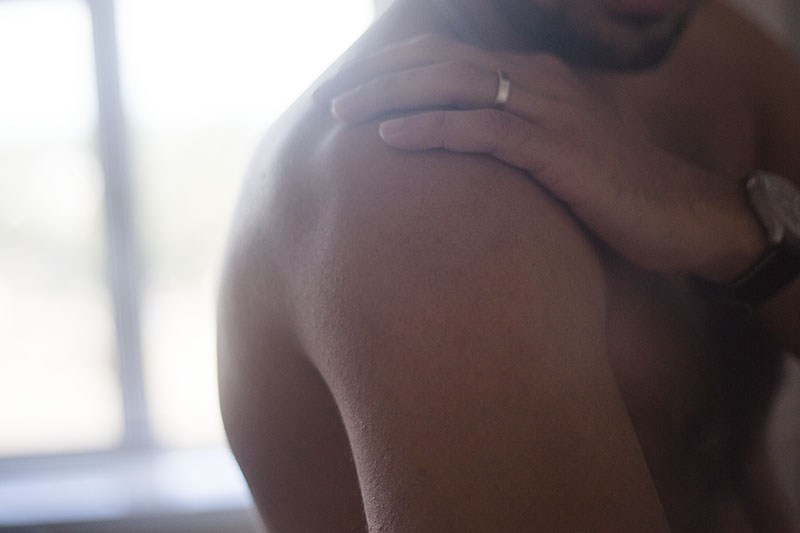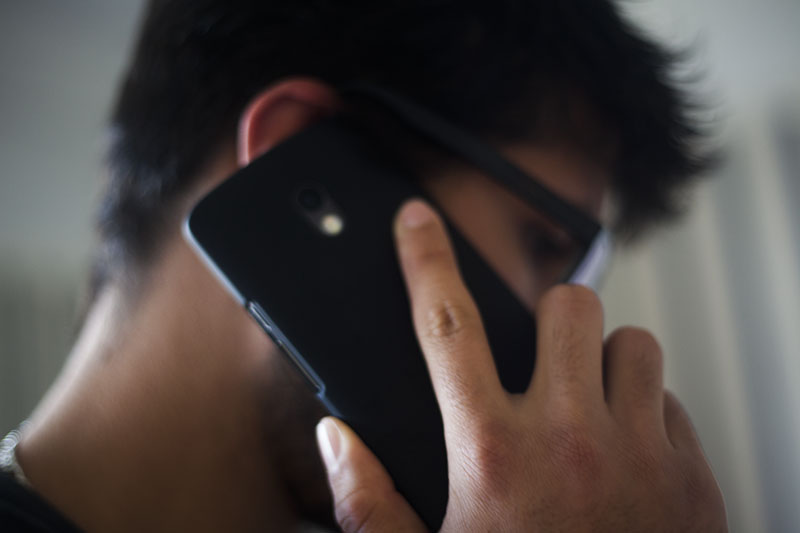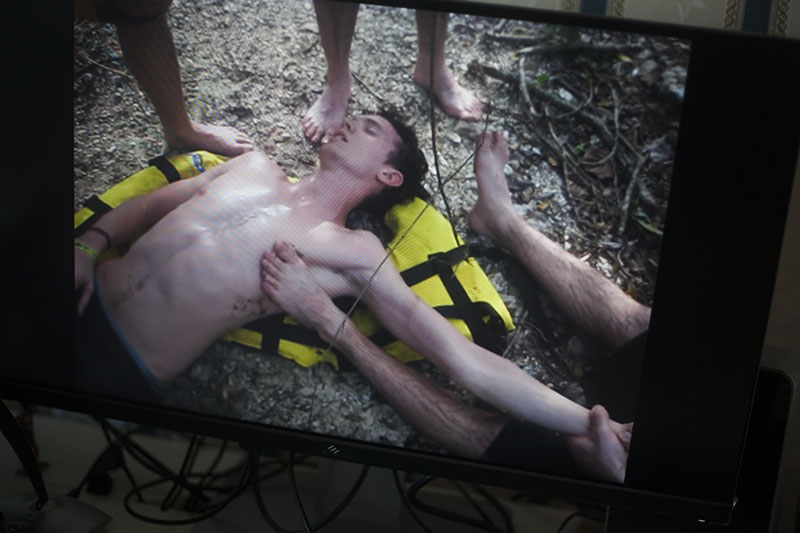Throwing your shoulder out happens. If you have boxed or been involved in combative sports (or sports in general for that matter) you have either had it happen to you or know someone who has. Personally, I have dislocated both my right and left shoulder on numerous occasions, and frankly don’t give it much thought.
One day a few years back, I had my best friend Jeremy over and we were sparring in the garage against a BOB punching dummy. I clipped the head at the wrong angle and out went my left shoulder. I decided to let Jeremy pop it back in, as he had never put back a dislocated shoulder before, and I figured it was a good opportunity to see how someone other than me would handle a situation like this firsthand.
Good thing to note: most people are very squeamish when it comes to physical first aid. They gingerly handle your bones with a general sense of unease. I understand why, it’s not your body and you don’t want to inflict pain on somebody else. However, the reality is that the longer you take, the more painful having that dislocated shoulder will become, and the more pain you will have when you do eventually get that shoulder popped back in. Before going over what happened to me in detail, let’s break down what a dislocated shoulder is and how it occurs, so you know how to identify there’s a problem –

Identifying a Dislocated Shoulder
Personally, I have only ever dislocated my shoulder when I’ve thrown a punch and it connected at such an angle that the momentum didn’t stop. But that’s me. Traditionally, a dislocated shoulders occur when falling (whilst having an arm outstretched) or having a strong force (think car crash as an example) slam into a body from behind. The internet tells me that you typically feel a sharp pain after experiencing a popping sound and/or feeling when you get a dislocated shoulder. I can’t personally agree with that, as in all my past experiences, I’ve felt a weird sliding pop sensation and then numbness. Pain only occurred afterwards for me (incrementally, the longer I left it dislocated). Obviously, with a dislocated shoulder, movement of the arm is painful, and the joint between your arm and shoulder will feel very tender. You’ll get intermittent bouts of sharp pain. This has been my experience, but your mileage may vary.
With that said, just look at the damned thing. I have never known someone with a dislocated shoulder to not visibly have… a dislocated shoulder. It looks funny; out of place. The shoulder visibly protrudes unnaturally outwards with a depression (groove) on the lateral muscle of the shoulder. I’d like to say it’s pretty self evident when you’ve got one, even if you’re looking at it yourself (without even needing a mirror to check). It’s rare for the shoulder to pop out in any way other that the anterior direction (outwards/to the front); I haven’t seen it nor experienced it come out any other way. 95% of the time (as per the internet), a dislocated shoulder is a result of the upper arm bone being pushed out of its socket, forward. This has been my experience time and time again, and likely what you will deal with the vast majority of the time.
In terms of long term risks, be aware that you can easily damage blood vessels if popping in a shoulder, and the result will be what appears to be bruising on the injured side (will turn red/blue/purple, just like any other bruise). Your arm will also feel cold, as you might expect. It should also be mentioned that the first time someone dislocates their shoulder, it’s a possibility (25% chance, roughly) that the upper area of the shoulder (girdle) will have fractures. Something to be aware of. A dislocated shoulder will often be different in terms of feel if it was the first time or a repeat injury. Repeat injuries shouldn’t feel as painful, though obviously it depends on your own body and pain tolerance, too. Not everyone is the same.
Disclaimers and More Disclaimers
Should you or someone near you have a dislocate their shoulder, immobilize it pronto (lie the injured party on their/your back and make sure the person does not move) whilst you assess what to do for your next step. As a citizen of a nanny state, I am supposed to tell you to seek professional medical help ASAP. Whilst there are risks to popping back in a shoulder (will be discussed in detail below), these risks are in my opinion pretty rare and infrequently come by. Obviously, seeking help to pop a dislocated shoulder back in, or even after you’ve popped a dislocated shoulder back in is 100% up to you, and the de facto mainstream opinion is to leave everything to the professionals. I would advise that if you have any doubts, or something seems off about the situation, hell even if it’s the injured’s first time to have dislocated his/her shoulder, pop by the ER or call 911 and wait for medics to arrive to do the deed and/or double check that everything’s okay.
Do not pop your own shoulder back in at all. Do not pop someone else’s shoulder back in, and do not let someone else pop a shoulder back in for you if you are not comfortable doing so. Period. In any of these cases, go to the ER or call 911 ASAP. If you notice complications or pain outside of what is to be expected, don’t be stupid. Get help.
I (personally) have never seen a dislocated shoulder that couldn’t be handled in 20 seconds by a semi-competent first aider. Obviously, this is just my experience and it’s 100% anecdotal, but then again, I don’t profess to be a mouthpiece for the medical industry that will charge you $500 for a dozen stitches that you could have dealt with at home with superglue for $2. I very much am a do it yourself kinda guy, and consequently you should take anything I scribble about with a bucketful of salt and understand that I speak from my experience and with my own very obvious biases. I do not fit the mainstream with regards to seeking outside help. As far as I am concerned, emergency services are there for emergencies. I do my own (minor) plumbing, electrical work, etc. myself as well. Plumbers, electricians, etc. are people I call on if I can’t do something myself, after first learning about the topic to see if I possibly can. So bare that in mind.
As a further disclaimer: if you have read any of my first aid articles in the past, you will know that on this blog I try to write in a way that is understandable and not quite scientific per say. My target demographic are not med students and thus I focus on the practicalities and getting the point across rather than the technical aspects of what I’m discussing. As a byproduct of that ideology, I describe your appendages in the manner in which most people are accustomed to discussing them colloquially – using the terms “shoulder,” “arm,” “ball” and “socket.” This is deliberate and not a mistake or lack of knowledge on my part. Again, I’m trying to make these concepts understandable to anyone who might read this.
Now that the disclaimers are out of the way, it’s time to get to the meat of this baby.

Risks of Popping a Dislocated Shoulder Back In
Gonna talk about these first, before I get to the procedure/how to pop a dislocated shoulder back in.
The risks are as follows:
- You could make the dislocated shoulder worse by tearing muscles, tendons, and ligaments.
- You could damage the nerves and blood vessels of the person with the dislocated shoulder, which in extreme cases can cause internal bleeding that can be fatal.
- You can end up with a situation where pain will be so severe for the person with the dislocated shoulder that their mind will opt to send him/her/you to lalala land. Loss of consciousness is very possible.
Once again, any of these risks are pretty rare. In my personal experience, well I’ve never seen any of these, and pain is marginal compared to what you might expect. I’ve dislocated my shoulder too many times to count, and in the worst cases, I’d say pain is a 4/10. But again, your mileage may vary. You may get very unlucky and end up coming face to face with one of the risks, or you may have a very low threshold for pain and end up with something closer to an 8/10 when popping a shoulder back in. Keep this in mind and use your better judgement to assess the risks and possible outcomes.
Benefits of Popping a Dislocated Shoulder Back In
Might as well go through the benefits while we’re at it.
- The longer it takes to pop a shoulder back in the more pain there will be – if you do it soon after it pops out, there will be relatively little pain by comparison to having waited to visit an ER or for emergency services to have arrived.
- Save money on medical procedures.
- Teach yourself/the person with you how to pop a dislocated shoulder back in and they know how to do it in case it happens another time.
- Save the emergency services for emergencies that can’t be dealt with without them.
That first reason is a huge boon in my opinion. Waiting for emergency services can take 20-25 minutes – that’s a long time for a dislocated shoulder to be without getting popped back in. In that time, in my opinion, you’d have a lot more pain than having done the job with help from those around you, which should happen within 5-10 minutes.
Again – weigh the risks with these potential benefits and make your own decision. You’re ultimately responsible for your own well being and for the well being of those you try to help, so please do be cautious and if you’re in any way uncomfortable, go seek help.

Procedure: If You Don’t Want to Pop a Dislocated Shoulder Back In
When dealing with someone else’s injury – always get consent before doing anything. In my opinion, if the person is a stranger (unless it’s an emergency) do not engage. As I wrote about before, your goal should be to come in the form of a good Samaritan, and not a hero who will eventually become the victim of a lawsuit; it’s not worth the risk of helping if the individual hurt does not want your help, not even if you really think you can do it perfectly. Often, it’s better to be an informed witness rather than an active helper anyway. Do not put yourself in a legal quandary just because you read about how to pop a shoulder back in on some blog on the internet. It’s a good skill to know for yourself or in an emergency – but do not, I repeat, do not go out and seek willing victims – your experience will surely end in tears.
If you are not going to pop the joint back in, first contact emergency medical services, then if you have ice, use it on the area to reduce inflammation. Also give the injured party anti-inflammatory medicine like Advil if you’ve got it on hand. Then simply sit back and wait for assistance.
And now the part you’ve all been waiting for.
Procedure: How to Pop a Dislocated Shoulder Back In
I will describe (to the best of my abilities) how you should do the deed, but frankly, watch the following video first – it’s much clearer when you see it done.
Caveat: The following video is by amateurs but I find the angle to be pretty darn perfect. It illustrates my own (real world) experiences perfectly.
In the case of yourself or a friend, obviously discuss the situation before doing anything. If the person who has the dislocated shoulder is fine with you popping it in, or if you’re the one with the dislocated shoulder and you’re happy letting the other person pop it back in, make this abundantly clear.
If you’re confident that everyone is a-okay about this happening, here’s what should be done:
- The injured party should lie on his/her back with both arms out at a 90 degree angle.
- The helper should then grab the hand (or wrist) belonging to the side with the injured shoulder and then slowly, but firmly (do not hesitate) pull.
- The helper may need additional leverage, and if this is the case, should place their feet against the injured person’s torso. The goal is to have the arm be pulled at an angle in which the ball of the arm (head of the humerus) smoothly pops back under the bone of the shoulder blade and into the socket where it should have stayed in the first place. Stupid bodies; bring on robotic upgrade please.
That’s pretty much all there is to it. You will feel and hear a clearly audible sound as the arm pops back into its socket and pain will be minimal (in my experience, I barely feel anything when I pop my shoulder back in or get someone else to do it for me). Beyond that, pop an Advil afterward, and don’t go lifting weights. To be on the safe side, place the injured arm in a sling and take it easy.
Why You Shouldn’t Pop a Dislocated Shoulder In Yourself
Remember how I said in part #3 of popping back in a shoulder that the helper may need additional leverage and should place their feet on the injured’s torso to get that dislocated shoulder back in if it needs more force? Well you can’t do that if you’re popping a shoulder back in yourself, and you honestly can make your dislocated shoulder worse if you fiddle around with it yourself without having the ability to get enough leverage to actually finish the job.
Just don’t try it okay. Not worth the risk in this case. Really it isn’t. Get some help – either from someone around you or from a medical professional – but do not try to do it yourself.

The Rest of My Story…
Yes, finally, back to my story. So I told Jeremy he should pop my shoulder back in, and told him verbally how to do it. Jeremy decided, as my shoulder arm was protruding grotesquely from my shoulder, that this was the perfect time to watch a video on how to pop dislocated shoulders back in. It’s fascinating to me that thanks to the internet, people feel a certain degree of “can do” as long as they have a tutorial up. After watching the video he recreated the scene he’d just watched, lay me on my back, and smoothly put my shoulder back in. It’d taken a while in the frenzy (first time happening with him around) to get everything well and done but he honestly did a good job and there wasn’t much pain for me at all. He didn’t hesitate once he’d watched the clip on the net, just got on with it, self-assured with the knowledge he’d gained from viewing a video just minutes before.
This is a very positive anecdote and represents (in my opinion) the best of the technological changes we have had over the past 20 years. My generation grew up with the internet (for the most part) and this second-nature to check what “Google” says on the matter has really changed the ball game. What would have happened 30 years ago in a similar situation? Perhaps Jeremy would’ve attempted to do what I recited, but maybe he wouldn’t have understood without a visual and therefore made it worse by trying. Or maybe, after attempting to explain and feeling it was hard to do without showing, I would have encouraged him to seek a first aid manual (which, lets be real, are hardly as clear as a video), would’ve added plenty extra time fumbling around looking for the right page, and therefore taken a long time to maybe have not even done the job right because of misunderstanding the pictures. Or perhaps he would have gotten nervous or accepted the limitations in being able to teach himself what to do, and therefore took my ass to/called for help from a medical professional.
The anecdote also represents, to me, how regular people, friends and family around you, can truly surprise you and step up when they’re needed. With just a request for help, a simple little nudge, and a good tutorial on the internet can inspire someone to help – that’s the kind of world I’m glad to be a part of.
More First Aid Resources
When it comes to first aid, you need two important things to help you on your quest to keep yourself and those around you safe & healthy: knowledge and (to a lesser extent) supplies. To tackle the prior, take a look through our list of the top 22 emergency & survival first aid books and grab those that you think will best help you gain the knowledge you’ll need. For the latter, take a look at our Ultimate First Aid Supplies List to see if there’s anything you should be adding to your at-home first aid supplies stockpile, or if there’s something you’ve forgotten to add to one of your first aid kits.
Do you know how to tell if a cut is infected, whether to use Advil, Tylenol, or Aspirin, and how to quickly assess and address emergency situations? Did you know you can superglue cuts and that Imodium is an excellent tool for survival?
Have some spare time? Quickly browse through all first aid articles published on this blog, in case there happens to be something valuable you’ve yet to learn on the topics we’ve written about.
Beware. Fifty-one years ago (Oct 13, 1965) my shoulder was dislocated. It’s not the kind of date you forget. The impact was straight from the side. The collar bone and the scapula separated. The head of the humerus fell out of the socket, and my arm hung there by the deltoid, completely disconnected from the joint. Not a good instance to try this method, so get professional help. Luckily help is better than it used to be.
Aye, obviously all situations have to be appraised on their own merit using our best judgement. For extreme cases, medical attention should be a priority and if someone is in any way uncomfortable with doing something themselves, then they should definitely seek professional assistance!